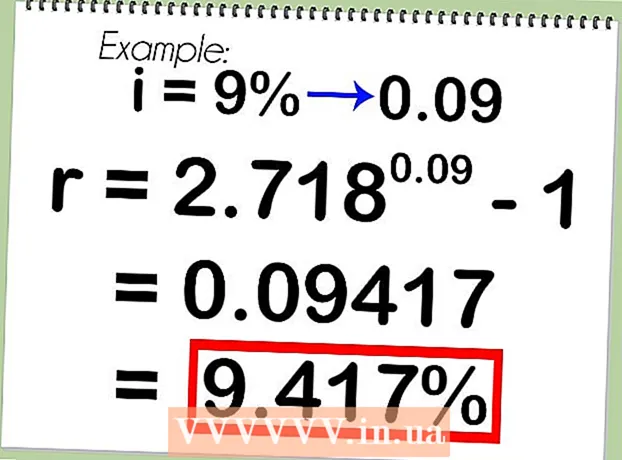
Content
- Steps
- Method 1 of 3: Using a detergent
- Method 2 of 3: Using vinegar and baking soda
- Method 3 of 3: Using an oven cleaner
- Tips
- Warnings
- What do you need
- Additional articles
Even attentive cooks sometimes burn their pans. Milk boiling too quickly, stirring infrequently or leaving the pan unattended can all cause food to burn, and it seems that this burnt layer cannot be cleaned off. Instead of immediately trying to scrape off the burnt layer with a wire scrubber, try other products that you probably have in your kitchen. Although the cleaning process will take some time, it will help prevent further damage to the cooking utensils.
Steps
Method 1 of 3: Using a detergent
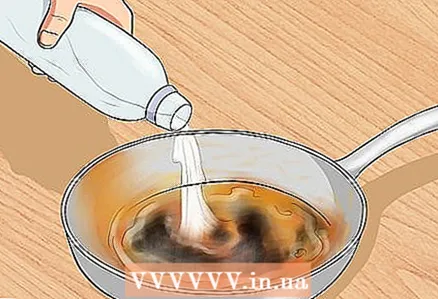 1 Fill the skillet with warm water. Take a dirty skillet and pour water into it so that it covers the burnt areas. Pour enough water so that it covers the bottom by 5–8 centimeters, as some of the water will evaporate when heated.
1 Fill the skillet with warm water. Take a dirty skillet and pour water into it so that it covers the burnt areas. Pour enough water so that it covers the bottom by 5–8 centimeters, as some of the water will evaporate when heated. - After you fill the pan with water, wipe the bottom of the pan to prevent water from dripping onto the hotplate when you reheat it again.
 2 Add a few drops of dish soap to the water. Since water alone is not enough to remove burn marks, you need a few drops of cleaning agent. Squeeze 3-4 drops of regular dish soap into the water and swirl the pan to spread it over the water.
2 Add a few drops of dish soap to the water. Since water alone is not enough to remove burn marks, you need a few drops of cleaning agent. Squeeze 3-4 drops of regular dish soap into the water and swirl the pan to spread it over the water. - For stubborn stains, it is better to use a dishwashing detergent powder or tablet rather than liquid soap. You can add one tablet, a few drops of liquid, or 1-2 tablespoons of dishwashing powder.
 3 Bring water to a boil. After dissolving the detergent in the water, place the pan on the stovetop. Turn on high heat and bring water to a boil. Boil water and detergent for 10-15 minutes to dissolve any dirt from the bottom of the pan.
3 Bring water to a boil. After dissolving the detergent in the water, place the pan on the stovetop. Turn on high heat and bring water to a boil. Boil water and detergent for 10-15 minutes to dissolve any dirt from the bottom of the pan. - Make sure that the water boils properly and not slightly gurgles. In this case, large bubbles should rise from the bottom of the pan, and steam will constantly flow from the water.
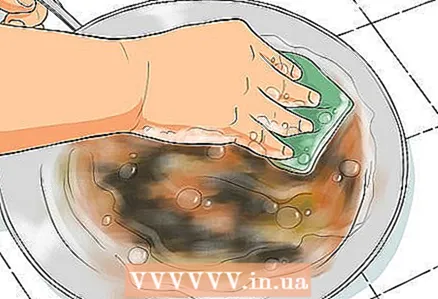 4 Refrigerate the pan and scrape the bottom. After you've boiled the water for about 10 minutes, remove the pan from the heat and let it cool completely (this will take about 20 minutes). Then pour out the water and detergent. You will most likely notice that the pan is slightly cleaner. Then, scrub the bottom of the pan with hot water and detergent to remove any burn marks and dirt.
4 Refrigerate the pan and scrape the bottom. After you've boiled the water for about 10 minutes, remove the pan from the heat and let it cool completely (this will take about 20 minutes). Then pour out the water and detergent. You will most likely notice that the pan is slightly cleaner. Then, scrub the bottom of the pan with hot water and detergent to remove any burn marks and dirt. - You may need some kind of hard sponge or other tool to completely remove the burn-on.A wire scrubber will work, but it can scratch the bottom of the pan and cause further damage. It is best to use a sponge in a plastic mesh to help scrape off the burn without scratching the pan.

Andrii Gurskyi
Cleaning professional Andriy Gursky is the owner and founder of Rainbow Cleaning Service, a New York-based cleaning company specializing in cleaning apartments and houses, including when moving, using non-toxic products without artificial fragrances. Founded Rainbow Cleaning Service in 2010 and has since served more than 35,000 clients. Andrii Gurskyi
Andrii Gurskyi
Cleaning professionalOur specialist agrees: “When rubbing a frying pan with a steel wool, there is a risk of damaging its surface, especially if it is non-stick. Better to do this: pour dishwashing detergent into the pan and add hot water; Place the skillet over medium heat. While hot, loosen the dirt with a wooden spoon. If that doesn't work, try drying wipes. "
Method 2 of 3: Using vinegar and baking soda
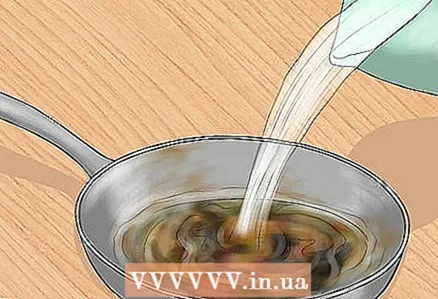 1 Fill the skillet with water. Start by pouring enough water into the skillet so that it covers the burnt spots on the bottom. The amount of water you need depends on the size of the pan, but one cup (250 milliliters) is enough to get started. If this is not enough, add more water until it covers all the burned areas.
1 Fill the skillet with water. Start by pouring enough water into the skillet so that it covers the burnt spots on the bottom. The amount of water you need depends on the size of the pan, but one cup (250 milliliters) is enough to get started. If this is not enough, add more water until it covers all the burned areas. 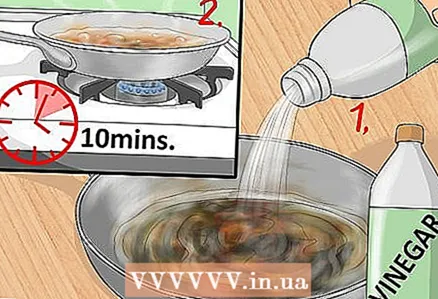 2 Add vinegar to the water and bring to a boil. After you have poured enough water into the pan, add vinegar to it. Pour 1 cup (250 ml) vinegar into a skillet and swirl the skillet lightly to mix the vinegar with the water. Place a skillet over high heat and bring the mixture to a boil. Boil it for about 10 minutes.
2 Add vinegar to the water and bring to a boil. After you have poured enough water into the pan, add vinegar to it. Pour 1 cup (250 ml) vinegar into a skillet and swirl the skillet lightly to mix the vinegar with the water. Place a skillet over high heat and bring the mixture to a boil. Boil it for about 10 minutes. - The amount of vinegar needed depends on the volume of water used. Add 1 part vinegar to 1 part water.
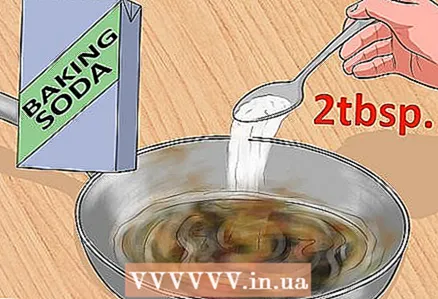 3 Remove skillet from heat and add baking soda. After boiling the water / vinegar mixture for 10 minutes, remove the pan from the heat and add 2 tablespoons (40 grams) of baking soda. The baking soda will react with the vinegar, resulting in a hiss and bubbles, which will help clear burns and dirt from the bottom of the pan.
3 Remove skillet from heat and add baking soda. After boiling the water / vinegar mixture for 10 minutes, remove the pan from the heat and add 2 tablespoons (40 grams) of baking soda. The baking soda will react with the vinegar, resulting in a hiss and bubbles, which will help clear burns and dirt from the bottom of the pan. - The pan will be hot when you add baking soda, so be careful not to touch it to avoid scalding.
- Let the baking soda and vinegar react until the end and let the pan cool down.
- Instead of baking soda, you can use tartar to remove any scorching from the skillet. However, you should not add vinegar to the water - just add 1 tablespoon (10 grams) of tartar to a glass (250 milliliters) of water.
- Baking soda works well on stainless steel pans, but baking soda and other alkaline cleaners should not be used on anodized aluminum utensils.
 4 Scrape off the dirt. Once the pan is cool, drain the mixture of water, vinegar, and baking soda and wash the pan with hot soapy water. Scrub the bottom of the pan with a plastic mesh sponge or brush to remove stubborn marks and dirt.
4 Scrape off the dirt. Once the pan is cool, drain the mixture of water, vinegar, and baking soda and wash the pan with hot soapy water. Scrub the bottom of the pan with a plastic mesh sponge or brush to remove stubborn marks and dirt. - When washing the pan, you can use a sponge in a plastic mesh or a dish brush, although the baking soda and boiling water should separate the burn from the surface of the pan, so it will not be difficult to remove it.
- If the burn is still not scraped off in some places, take some baking soda and add a few drops of water to it, so that you get a pasty mass. Apply this mixture to problem areas and wait 10-15 minutes, then wash the pan as described above.
- If burn marks are difficult to remove, you may need to repeat this process several more times.
Method 3 of 3: Using an oven cleaner
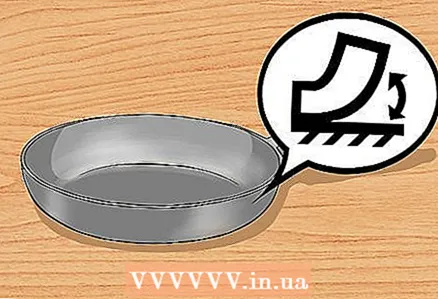 1 Make sure the pan is not coated with a non-stick coating. Oven cleaner works well to remove burn marks from utensils, but should be used as a last resort as it is extremely caustic and can discolor the pan. Never use this cleaner on pans with non-stick or other protective coatings, as it will remove the coating and damage the utensils.
1 Make sure the pan is not coated with a non-stick coating. Oven cleaner works well to remove burn marks from utensils, but should be used as a last resort as it is extremely caustic and can discolor the pan. Never use this cleaner on pans with non-stick or other protective coatings, as it will remove the coating and damage the utensils. - As oven cleaner can damage your utensils, use this method only if other methods have failed. If all else fails and you are about to throw out the dirty pan, try this method.
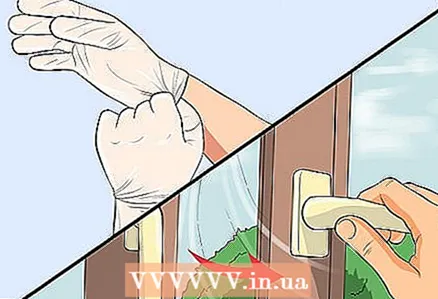 2 Put on your gloves and open the window. Oven cleaner contains corrosive substances that produce corrosive vapors, therefore precautions should be taken before use. Wear rubber gloves on your hands to protect your skin from corrosive substances. Also make sure the kitchen is well ventilated and open a window (or windows if there are several).
2 Put on your gloves and open the window. Oven cleaner contains corrosive substances that produce corrosive vapors, therefore precautions should be taken before use. Wear rubber gloves on your hands to protect your skin from corrosive substances. Also make sure the kitchen is well ventilated and open a window (or windows if there are several). - If you are sensitive to odors, you may want to cover your nose and mouth with a gauze bandage to keep out fumes when using an oven cleaner.
- Be sure to read and follow the safety instructions on the packaging of your oven cleaner.
 3 Apply oven cleaner to the bottom of the pan. Once you're ready to use the product, apply it to the burned-on areas of the pan. Since this product is very aggressive, do not use too much of it - it is enough if it covers the bottom of the pan with a thin layer. You can rub it over the bottom of the pan with a brush.
3 Apply oven cleaner to the bottom of the pan. Once you're ready to use the product, apply it to the burned-on areas of the pan. Since this product is very aggressive, do not use too much of it - it is enough if it covers the bottom of the pan with a thin layer. You can rub it over the bottom of the pan with a brush. - Although the most common oven cleaner is spray, it is also available in the form of a cream or foam, which is more convenient for cleaning a burnt frying pan.
 4 Cover the skillet and set it aside. In order for the cleaning agent to properly penetrate the burn layer and act on it, you must leave it in the pan for at least half an hour. Because of the harmful fumes, it is best to expose the pan with the detergent to the outside. Cover the pan with a lid and place it on a table in the yard, balcony or loggia.
4 Cover the skillet and set it aside. In order for the cleaning agent to properly penetrate the burn layer and act on it, you must leave it in the pan for at least half an hour. Because of the harmful fumes, it is best to expose the pan with the detergent to the outside. Cover the pan with a lid and place it on a table in the yard, balcony or loggia. - If you can't put the pan out of the house, open a window and place it on the windowsill.
 5 Scrape and wash the pan thoroughly. After the detergent has worked for about half an hour, scrub the pan with a stiff brush or sponge. Burn and dirt should come off easily. Thoroughly clean the pan and wash it thoroughly so that no traces of oven cleaner remain on it.
5 Scrape and wash the pan thoroughly. After the detergent has worked for about half an hour, scrub the pan with a stiff brush or sponge. Burn and dirt should come off easily. Thoroughly clean the pan and wash it thoroughly so that no traces of oven cleaner remain on it. - If you're worried that there might be some cleaning agent left in the pan, wipe it off with a dry towel after washing and see if it gets dirty. If you notice any residue on the towel, be sure to rinse the pan again, even if it seems clean.

Andrii Gurskyi
Cleaning professional Andriy Gursky is the owner and founder of Rainbow Cleaning Service, a New York-based cleaning company specializing in cleaning apartments and houses, including when moving, using non-toxic products without artificial fragrances. Founded Rainbow Cleaning Service in 2010 and has since served more than 35,000 clients. Andrii Gurskyi
Andrii Gurskyi
Cleaning professionalWhen all else fails, Weiman is worth a try... Weiman is a stainless steel dishwashing detergent that removes burn marks on ceramic and non-stick pans. When doing this, use a cloth napkin that should be somewhere between a steel wool and a microfiber in texture.
Tips
- Before trying any method to remove the burn, try simply soaking the skillet in hot water to remove any dirt. Pour hot water into the pan and leave for at least half an hour, or better all night.
- Vinegar and baking soda and oven cleaner are suitable for stainless steel pans, but should not be used on anodized aluminum utensils and Teflon pans.
- Try cleaning a burnt Teflon-coated pan with a dish detergent that's safe for this type of utensil.
- Anodized aluminum pans should only be hand washed in hot water and soap.
Warnings
- Before using any cleaning products, be sure to read the rules for using a particular utensil. Some ingredients can damage the pan material. The instructions that came with the pan may have recommendations on how to remove burn marks from the pan.
- Make sure the pan is completely cool before cleaning it, otherwise you may get burned.
What do you need
- Kitchen sponge
- Baking soda
- Vinegar
- Dishwashing liquid
- Oven cleaner
- Latex gloves
Additional articles
How to clean stainless steel cookware How to clean a copper object How to clean coins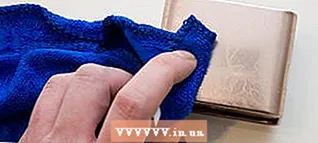 How to clean brass products
How to clean brass products 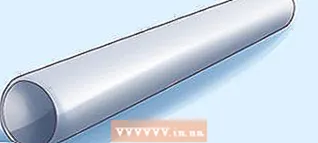 How to prevent metal corrosion
How to prevent metal corrosion 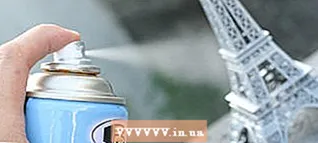 How to paint metal
How to paint metal 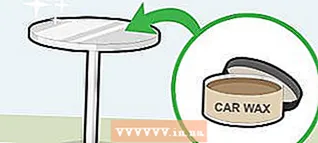 How to clean aluminum How to polish stainless steel
How to clean aluminum How to polish stainless steel 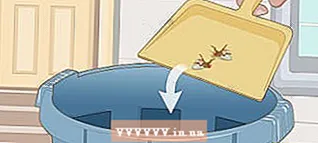 How to kill a fly quickly
How to kill a fly quickly 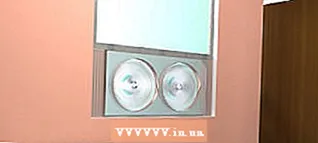 How to use fans to cool your home How to open a lock How to open a lock with a hairpin or hairpin
How to use fans to cool your home How to open a lock How to open a lock with a hairpin or hairpin  How to calculate the power consumption of an electrical appliance
How to calculate the power consumption of an electrical appliance  How to kill flying ants
How to kill flying ants



